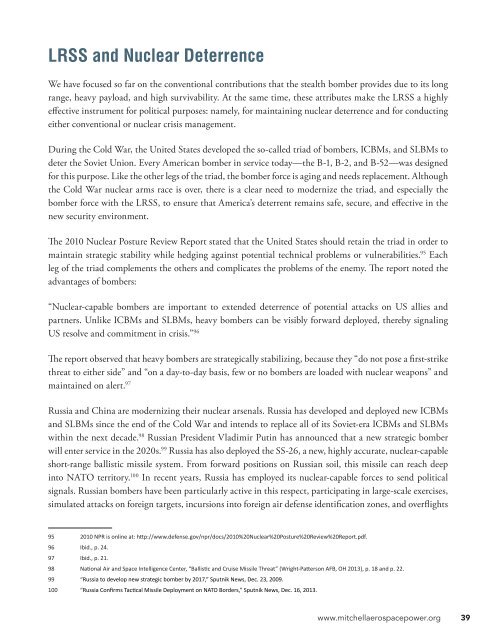Create successful ePaper yourself
Turn your PDF publications into a flip-book with our unique Google optimized e-Paper software.
LRSS and Nuclear Deterrence<br />
We have focused so far on the conventional contributions that the stealth bomber provides due to its long<br />
range, heavy payload, and high survivability. At the same time, these attributes make the LRSS a highly<br />
effective instrument for political purposes: namely, for maintaining nuclear deterrence and for conducting<br />
either conventional or nuclear crisis management.<br />
During the Cold War, the United States developed the so-called triad of bombers, ICBMs, and SLBMs to<br />
deter the Soviet Union. Every American bomber in service today—the B-1, B-2, and B-52—was designed<br />
for this purpose. Like the other legs of the triad, the bomber force is aging and needs replacement. Although<br />
the Cold War nuclear arms race is over, there is a clear need to modernize the triad, and especially the<br />
bomber force with the LRSS, to ensure that America’s deterrent remains safe, secure, and effective in the<br />
new security environment.<br />
The 2010 Nuclear Posture Review Report stated that the United States should retain the triad in order to<br />
maintain strategic stability while hedging against potential technical problems or vulnerabilities. 95 Each<br />
leg of the triad complements the others and complicates the problems of the enemy. The report noted the<br />
advantages of bombers:<br />
“Nuclear-capable bombers are important to extended deterrence of potential attacks on US allies and<br />
partners. Unlike ICBMs and SLBMs, heavy bombers can be visibly forward deployed, thereby signaling<br />
US resolve and commitment in crisis.” 96<br />
The report observed that heavy bombers are strategically stabilizing, because they “do not pose a first-strike<br />
threat to either side” and “on a day-to-day basis, few or no bombers are loaded with nuclear weapons” and<br />
maintained on alert. 97<br />
Russia and China are modernizing their nuclear arsenals. Russia has developed and deployed new ICBMs<br />
and SLBMs since the end of the Cold War and intends to replace all of its Soviet-era ICBMs and SLBMs<br />
within the next decade. 98 Russian President Vladimir Putin has announced that a new strategic bomber<br />
will enter service in the 2020s. 99 Russia has also deployed the SS-26, a new, highly accurate, nuclear-capable<br />
short-range ballistic missile system. From forward positions on Russian soil, this missile can reach deep<br />
into NATO territory. 100 In recent years, Russia has employed its nuclear-capable forces to send political<br />
signals. Russian bombers have been particularly active in this respect, participating in large-scale exercises,<br />
simulated attacks on foreign targets, incursions into foreign air defense identification zones, and overflights<br />
95 2010 NPR is online at: http://www.defense.gov/npr/docs/2010%20Nuclear%20Posture%20Review%20Report.pdf.<br />
96 Ibid., p. 24.<br />
97 Ibid., p. 21.<br />
98 National Air and Space Intelligence Center, “Ballistic and Cruise Missile Threat” (Wright-Patterson AFB, OH 2013), p. 18 and p. 22.<br />
99 “Russia to develop new strategic bomber by 2017,” Sputnik News, Dec. 23, 2009.<br />
100 “Russia Confirms Tactical Missile Deployment on NATO Borders,” Sputnik News, Dec. 16, 2013.<br />
www.mitchellaerospacepower.org 39


